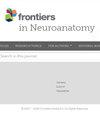细胞结构上不同的人类左颞极亚区结构连通性:扩散MRI束状图研究
IF 2.1
4区 医学
Q1 ANATOMY & MORPHOLOGY
引用次数: 0
摘要
颞极(TP)被认为是脑皮层旁缘的主要区域之一,并参与多种功能,如感觉知觉、情感、语义加工和社会认知。基于细胞结构的差异,TP可以进一步细分为更小的区域(背侧、腹内侧和腹内侧),每个区域形成不同功能网络的关键节点。然而,TP亚区的脑结构连通性尚不完全清楚。利用31名健康受试者的弥散MRI数据,我们旨在阐明三个细胞结构不同的TP亚区的全面结构连通性。弥散张量成像(DTI)分析表明,下纵束、中纵束、弓形束和钩侧束等主要的关联纤维通路提供了TP的结构连接。进一步的分析表明,TP子区域的结构连接模式部分重叠,但仍然明显。具体来说,背侧亚区与顶叶的广阔区域紧密相连,腹侧亚区与默认语义网络的组成区域紧密相连,腹内侧亚区与边缘和旁边缘区域紧密相连。我们的研究结果表明,TP参与了一系列广泛而独特的皮质区域网络,与其功能角色一致。本文章由计算机程序翻译,如有差异,请以英文原文为准。
Structural connectivity of cytoarchitectonically distinct human left temporal pole subregions: a diffusion MRI tractography study
The temporal pole (TP) is considered one of the major paralimbic cortical regions, and is involved in a variety of functions such as sensory perception, emotion, semantic processing, and social cognition. Based on differences in cytoarchitecture, the TP can be further subdivided into smaller regions (dorsal, ventrolateral and ventromedial), each forming key nodes of distinct functional networks. However, the brain structural connectivity profile of TP subregions is not fully clarified. Using diffusion MRI data in a set of 31 healthy subjects, we aimed to elucidate the comprehensive structural connectivity of three cytoarchitectonically distinct TP subregions. Diffusion tensor imaging (DTI) analysis suggested that major association fiber pathways such as the inferior longitudinal, middle longitudinal, arcuate, and uncinate fasciculi provide structural connectivity to the TP. Further analysis suggested partially overlapping yet still distinct structural connectivity patterns across the TP subregions. Specifically, the dorsal subregion is strongly connected with wide areas in the parietal lobe, the ventrolateral subregion with areas including constituents of the default-semantic network, and the ventromedial subregion with limbic and paralimbic areas. Our results suggest the involvement of the TP in a set of extensive but distinct networks of cortical regions, consistent with its functional roles.
求助全文
通过发布文献求助,成功后即可免费获取论文全文。
去求助
来源期刊

Frontiers in Neuroanatomy
ANATOMY & MORPHOLOGY-NEUROSCIENCES
CiteScore
4.70
自引率
3.40%
发文量
122
审稿时长
>12 weeks
期刊介绍:
Frontiers in Neuroanatomy publishes rigorously peer-reviewed research revealing important aspects of the anatomical organization of all nervous systems across all species. Specialty Chief Editor Javier DeFelipe at the Cajal Institute (CSIC) is supported by an outstanding Editorial Board of international experts. This multidisciplinary open-access journal is at the forefront of disseminating and communicating scientific knowledge and impactful discoveries to researchers, academics, clinicians and the public worldwide.
 求助内容:
求助内容: 应助结果提醒方式:
应助结果提醒方式:


